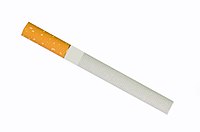
Photo from wikipedia
Metal(loid) contamination of vital food grains such as wheat and rice is a very serious problem throughout the world because consumption of such contaminated food can lead to severe health… Click to show full abstract
Metal(loid) contamination of vital food grains such as wheat and rice is a very serious problem throughout the world because consumption of such contaminated food can lead to severe health effects in humans. Metal(loid) contamination of food crops can occur from different sources such as contaminated soil, irrigation water, and aerial deposition. Therefore, the present study was conducted to analyze potential non-carcinogenic and carcinogenic health impacts posed by different metal(loid)s (As Cd, Co, Cr, Cu, Fe, Mn, Mo, Ni, Pb, Se, and Zn) via consumption of wheat and rice grown on metal(loid)-contaminated soils in areas around rivers (Beas and Sutlej) of Punjab, India. Among the metal(loid)s analyzed in wheat and rice samples, contents of As, Cd, Cr, Ni, and Pb were found to be above the international (FAO/WHO and EU) maximum permissible limits. The non-carcinogenic and carcinogenic health risk assessment of individual metal(loid)s revealed that As posed highest risk followed by Cd, Cu, Fe, Mn, and Pb. The values of indices calculated for analysis of combined non-carcinogenic, i.e., (hazard index; range 3.49–15.94) and carcinogenic (total carcinogenic risk index; range 8.30 × 10 −4 –131.62 × 10 −4 ) risks for both crops were found to be many fold higher than the prescribed limits of 1.0 and 1.0 × 10 −4 , respectively. Thus, the analysis of combined risks posed by metal(loid)s indicated that human population consuming wheat and rice from the study area faced both non-carcinogenic and carcinogenic health risks. Therefore, immediate steps must be taken to reduce the levels of metal(loid)s in wheat and rice from the study area.
Journal Title: Environmental Science and Pollution Research
Year Published: 2020
Link to full text (if available)
Share on Social Media: Sign Up to like & get
recommendations!